March 11, 2015
If the winners of the Flexible Packaging Assn.'s (www.flexpack.org) 2008 Packaging Achievement Awards competition are any indication, flexible packaging continues to flourish, as the FPA's 52nd packaging competition underscores plenty of innovation taking place in the flexible packaging market. Judged on outstanding converting and packaging in four categories: packaging excellence; technical innovation; environmental achievement; and printing achievement, the winners feature new combinations of materials, inventive structural designs and applications that have amplified the use of flexible packaging within the retail, institutional, and industrial markets.
Announced on March 5 in Orlando, FL, the competition generated 75 entries and 99 competition category entries this year, with 26 receiving a total of 29 Achievement Awards.
The winners make the most of looks, ease of use, functionality and sustainability – a key buzzword of the new millennium, which is prevalent here, with winning packages that use less fossil fuel, produce less CO2 emissions and represent a reduction in solid waste. Environmental achievements are seen in many winning flex-packs, such as a pouch that replaces rigid packaging for carpet cleaner tablets and a compact, retortable package for ready-to-heat sauces.
Technological improvements to a vegetable steaming package result in a microwaveable cook-in bag with improved venting systems. Printing achieves bright colors, superior registration and large billboard display space for an easy-open/resealable bag containing frozen chicken, and resealable features are welcome attributes for bags of gourmet cat food.
The top winners include nine gold awards and two Highest Achievement winners in two categories, as well as two gold winners in the Environmental and Sustainability Achievement category. All are described here. The entire article, which also details the silver award winners, can be found on our website at www.packagingdigest.com/silver08.
Top achievements
A curvy pouch that conveys what's inside and how it's used, the Royco Sauce Pouch submitted by CLP Packaging Solutions, Inc. (www.clppackaging solutions.com), took the Highest Achievement Award in the 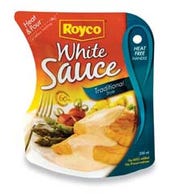 Packaging Excellence category. A microwaveable package with a secure-grip, “no-heat” handle that performs well in a retort chamber, on the shelf and in the kitchen, the shapely pouch holds 200 mL of Royco heat-and-serve sauces and gravies, a new product entry from Masterfoods South Africa Ltd., Cape Town, South Africa. The heat-and-pour sauce pouch is Masterfoods' first departure from dry-food packaging and protects the contents with outstanding barrier properties.
Packaging Excellence category. A microwaveable package with a secure-grip, “no-heat” handle that performs well in a retort chamber, on the shelf and in the kitchen, the shapely pouch holds 200 mL of Royco heat-and-serve sauces and gravies, a new product entry from Masterfoods South Africa Ltd., Cape Town, South Africa. The heat-and-pour sauce pouch is Masterfoods' first departure from dry-food packaging and protects the contents with outstanding barrier properties.
The nonfoil, four-ply adhesive-laminated construction allows the stand-up pouch to remain stable during heating while its heat-free handle avoids the discomfort that often accompanies grasping a hot pouch from the microwave oven.
The pouchstock comprises polyethylene terepthlatate, a high-barrier PET layer, a biaxially oriented nylon layer that adds puncture-resistance, elasticity and thermomechanical performance and a layer of white polypropylene, which creates a rich backdrop for the reverse-printed graphics on the PET top layer without requiring a thick layer of white ink on-press. This saves money and makes printing and drying more efficient, says CLP Packaging Solutions president of U.S. operations, Ehud Safrai. The package uses adhesives and nylon from Italy's CFP Flexible Packaging S.p.A. (www. www.cfp-flex.it/), adhesives from Rohm & Haas (www.rohmhaas.com), PET from Kolon Industries (www.ikolon.com), a PET Alumina Barrialox barrier PET layer (that allows the pouch to be retorted without the need for a foil layer, which also makes it microwavable) from Toray Intl. (www.toray.co.jp), polypropylene from Israel's Polyon Industries Ltd. (www.polyon.co.il/), and inks from Siegwerk Druckfarben AG (www.siegwerk.de). It is said to offer a cost-effective alternative to its rigid counterparts.
CLP designed the value-added structure with a large contoured handle area for a comfortable grip. The handle is sealed so that hot sauce can't come in contact with fingers during transport and pouring. The gravy-pitcher shape of the package makes use very intuitive, enhances eye appeal and facilitates pouring while the handle makes it easier to pick up the heated pouch. The shape communicates an important brand message and easy cues to the package's functionality. A hole die-cut into the handle allows consumers to get a good grip, and allows retailers to display the sauces on a rack.
Produced in Israel by parent company, CLP Industries Ltd., the pouch is 139 microns (5.4 mils) thick overall. CLP Industries gravure-prints the pouch material on a Cerutti (www.cerutti.it) press, which makes strong use of bold fields of color, elegant color grades and lifelike, halftone graphics. The pouchstock is laminated on a system from Valmet Rotomec (www.valmet.com).
Lightweight and easy to store, the pouch eliminates the need for washing and drying gravy boats and saves more energy in transport, than comparably sized rigid containers, according to CLP Packaging. It's shipped to the packager as a preformed pouch, so it can be filled and sealed quickly and reliably. “The pouch represents the best attributes of flexible packaging—reliability, performance, convenience and outstanding consumer appeal,” sums up Safrai.
Souped-up membrane
The second Highest Achievement award winner—this one in the Technical Innovation category, is the Ultra 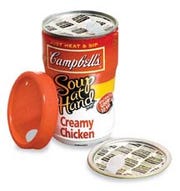 Peel retortable membrane end, entered by Watson Standard Adhesives (401/225-5260) for Campbell Soup Co.'s Soup at Hand containers. Adopted for Tomato and Creamy Chicken varieties, the entry is also a gold winner in Technical Innovation. The membrane end is said to be the first retortable, peelable membrane end in the U.S. market and represents significant advancements over existing retortable end technology in an economical, easy-to-use, safe-to-open format. Equipped with a handy pull-tab, the proprietary reverse-printed membrane structure comprises a three-layer adhesive laminate of polyester/foil/polypropylene with superior opening initiation and an even draw, as well as a controlled peel, according to Watson Standard.
Peel retortable membrane end, entered by Watson Standard Adhesives (401/225-5260) for Campbell Soup Co.'s Soup at Hand containers. Adopted for Tomato and Creamy Chicken varieties, the entry is also a gold winner in Technical Innovation. The membrane end is said to be the first retortable, peelable membrane end in the U.S. market and represents significant advancements over existing retortable end technology in an economical, easy-to-use, safe-to-open format. Equipped with a handy pull-tab, the proprietary reverse-printed membrane structure comprises a three-layer adhesive laminate of polyester/foil/polypropylene with superior opening initiation and an even draw, as well as a controlled peel, according to Watson Standard.
Able to withstand saturated steam retorting at temperatures of at least 250 deg F for 1 hr, the flexible membrane is peeled away by the consumer and is considered safer and more easily disposable than a sharp-edged alternative, says Bill Allen, manager of market development at Watson Standard. “The lacquered rings sealing to the peelable membrane make up the end. When the consumer peels the membrane away from the ring, they have a flexible piece of laminated film and foil with no sharp edges.”
The Ultra Peel ends for retort packaging represent a market expansion possibility for flexible/rigid package hybrid designs, notes Allen. The lidding is made of a film laminate while many other can membrane lids are made of heavy-gauge aluminum, often coated with an extruded polymer, he explains.
“The alternate membranes are usually less flexible and have a more aggressive peel,” he adds. The Ultra Peel membrane has a more even and consistent peel than a rigid aluminum EZO end and has no sharp edges once the container is open.” A distinction between Ultra Peel and flexible film membranes often used outside of the U.S. is that they are primarily made of aluminum and use polymer-coated rings, not lacquered rings, he says.
Eliminating sharp edges is accomplished with a retortable heat-sealable polypropylene dispersion in a solvent-based lacquer used on the Ultra Peel ring that allows for a controlled peel between the ring and the film laminate membrane. The lidding's patented construction is designed to withstand the demands of the retort environment while offering superior shear-resistance during the retort process. While attached to the rigid can, it won't flex or impart severe stresses on the flexible laminate, according to Watson Standard. The laminate structure also has strength, a superior initiation and an even draw for opening easily spillable liquid containers, and it's puncture-resistant and printable. Lacquers on the ring stock provide for heat sealing and protection of the retort curl.
The Ultra peel membrane etook more than two years to develop. Allen says that the end is assembled in Canton, OH, at Sonoco's (www.sonoco.com) Sonoco-Phoenix Packaging plant and is reverse-printed by flexography on the polyester layer in a single color with heating instructions and Campbell's logo. Allen adds that while Ultra Peel is currently commercialized for use as the lidding material for Campbell's, several other soup and food producer/marketers are expected to use it for applications requiring peelable lidding. Originally in a test rollout in 2007, the Soup at Hand containers featuring the new lid will expand distribution in 2008, notes Allen. PD hears that Campbell's will implement a more extensive conversion to the new end for production in 2008.
Gold awards
For tea with no strings or loose leaves floating in your cup, the Sugart iTea Wand, marketed and distributed by Sugart Group USA, Manchester, NH in conjunction with Bistrotea, is a new “designer” product that offers a unique way to brew tea. Functioning as a tea infuser, the wand-like stick-pack has a built-in, mechanical filter system that restricts the bitter components within a tea “pod,” while releasing a perfectly brewed tea serving.
Launched in mid-2007, the teas are available across North America. Just drop the pod, or stick-pack, into hot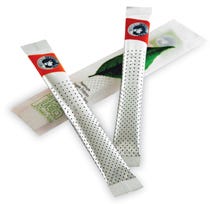 water. Perforated all over for optimum brewing performance, the iTea Wand is a fresh design for the modern, on-the-go tea consumer, according to Sugart Group. It eliminates the need for a teaspoon and minimizes dripping. Natural tea is usually contained in a filter bag where water can interact with the leaves to brew. But the tube-shaped stick-pack, developed over the course of six years, provides excellent performance and is convenient for on-the-go consumers.
water. Perforated all over for optimum brewing performance, the iTea Wand is a fresh design for the modern, on-the-go tea consumer, according to Sugart Group. It eliminates the need for a teaspoon and minimizes dripping. Natural tea is usually contained in a filter bag where water can interact with the leaves to brew. But the tube-shaped stick-pack, developed over the course of six years, provides excellent performance and is convenient for on-the-go consumers.
Converted by Alcan Packaging (www.alcanpackaging.com), the package won a gold award for Packaging Excellence. Comprising an integrated mechanical filter system the stick-pack shows no interaction during the release of the tea liquor with the flavor, resulting in a richly flavored tea beverage. Each slender “stick” contains a single serving of Premium Single Estate Ceylon Earl Grey, Bistro Ceylon Green Tea or Single Estate Ceylon Black Tea and contains 1.5 g of loose tea leaves.
Made by Alcan in Germany, which developed the film for the package in conjunction with Germany's Bistrozucker (www.bistrozucker.de.)The stick-pack film is a proprietary multilayer adhesive laminate of PP and foil, incorporating thousands of microperforations. Alcan Food Americas is facilitating the material's commercialization in North America. It can be filled on equipment from Bosch Sigpack Systems AG (www. pa.bosch.com/sigpacksystems/eng/index.asp), according to Alcan.
Printing of the color-coded flavor description on one end of each stick is performed on conventional equipment, Alcan says. The metallized look promotes a premium image for the tea while the glassine-like envelope in which the tube is inserted is printed with the same color scheme and a large, brightly colored tea leaf in the center, which is not only eye-catching but intricately detailed.
Adds an Alcan spokesman, “The perforation process and the laminate have to be compatible.” Measuring about 5-in.-long and 5/8 in. wide, the stick-pack uses a minimum of packaging material per serving versus a rigid container or the conventional tea bag/overwrap/carton package often found in the retail market.
Each stick is housed in a colorfully printed, translucent paper envelope designed by Germany's Sihl GmbH (www.sihl.de) to incorporate moisture- and tear-resistance and aroma protection.
Label this deli pack reclosable
Value-added features such as an easy-to-open device and a strong repeat closure are found in Daniele, Inc.'s Delizia Presidents Prosciutto package. Using less packaging material than comparably sized rigid tubs and deli clamshells, the space-efficient package fits the bill as an environmentally friendly package. Incorporating Re-Seal-It™ technology from Printpack, Inc. (www.printpack.com), the reclosable pack won a gold award for Packaging Excellence.
Printpack says the header space is reduced by as much as 1¾ in. versus a slider and a zipper package because it reduces the size of the stockkeeping units that can be put into the same space on a store shelf.
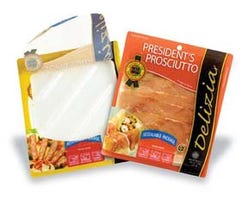 Combining proprietary label technology with high-performing barrier films, the new deli pack was designed and engineered with consumers, retailers and food processors in mind. The package holds 4 oz of sliced prosciutto. The resealable device is a label, made with a glossy polypropylene film facestock and a proprietary, removable acrylic-based adhesive that functions effectively with meat and other wet/fatty foodstuffs, says Printpack. The label is applied to a printed PET-based barrier film.
Combining proprietary label technology with high-performing barrier films, the new deli pack was designed and engineered with consumers, retailers and food processors in mind. The package holds 4 oz of sliced prosciutto. The resealable device is a label, made with a glossy polypropylene film facestock and a proprietary, removable acrylic-based adhesive that functions effectively with meat and other wet/fatty foodstuffs, says Printpack. The label is applied to a printed PET-based barrier film.
“Most zipper and slider packages require a large header to accommodate that resealable feature, so they require extra packaging film,” explains Printpack's market development manager Tony Alvarez. “Re-Seal It uses no slider or zipper closure, so the package can hold as much but reduces a lot of header space.”
The Re-Seal It easy-open label provides a repeat reseal for thermoforms like the Daniele prosciutto package, which, is made of Neobar,™ a coex APET/ethylene vinyl alcohol/polyethlyene forming film made by Neoplastica (www.neoplastica.com.br).
To open the package, the user peels back the Re-Seal It label on the top. The label opens like a flap, providing full access to the product, with no “throat-opening” constraint, no scored film headers and no additional peel-seal films to break through. A swipe of the label recluses the package. The flap of the film sticks to the back of the label.
The peel-and-reclose label is part of a Printpack packaging system, which includes a label “applicator” that can be mounted onto an existing thermoform/fill/seal line. The applicator makes a fine perforation in the packaging film and then places a label precisely over the perforation without removing any part of the film. The package is gas-flushed and packaged under modified atmosphere to preserve freshness and shelf life.
Alvarez adds that the food-grade/meat-grade label material can be used with Printpack's PerformX™ barrier films or the Neobar rigid sheet, which both perform well with vacuum-packed or modified atmosphere packaging thermoform barrier applications.
Macfarlane Group (www.macfarlanegroup.net), a strategic supply partner of Printpack's in Kilmarnock, Scotland, produces and provides the label to Daniele's exclusively through Printpack, which gravure-prints the package graphics in eight colors at its Elgin, IL, facility, in a red, black and gold color scheme.
The package has a clear film window on the front panel to enhance product visibility. For the Pascoag, RI-based Daniele, Inc., which produces assorted Italian-style gourmet meats and other foods, the labels provide the opportunity to differentiate its prosciutto with an easy-to-use convenience feature. The new package was launched in September 2007 on the East Coast at ShopRite stores and Grace's Market in New York City.
Enviro-friendly cleaner package
The Drop 'n Go Deep Cleaning Tablets carpet cleaner pouch marketed by Milliken Chemical, Spartanburg, SC, won a gold award for Environmental & Sustainability Achievement for North State Flexibles LLC (www.nsflexibles.com). Representing an environmentally friendly move through the use of nonvolatile water-based adhesives, the package, designed by Milliken, holds 60 g of concentrated cleaner tablets. The pouch material is described by North State Flexibles as a 4.-5-mil solventless metallized polyester adhesive lamination comprising PET and an undisclosed sealant.
Designed to dissolve in the water reservoir of most steam cleaners, each cleaning tablet makes the equivalent of 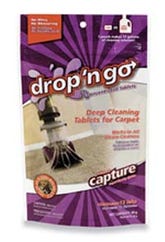 1 gal of cleaning solution. A reduction of energy, water and material waste, along with an improved product formulation and a user-friendly, press-to-close resealable feature made by North State Flexibles, are all bonuses for Drop 'n Go. The pouch significantly reduces weight and cube dimensions., while saving approximately eight times the warehouse space of its one-gal predecessor, described as a high-density polyethylene liquid container that weighed more than 50 lb and consumed eight times the landfill spac. Millliken also realizes lower packing materials costs, freight savings and markedly lower energy consumption.
1 gal of cleaning solution. A reduction of energy, water and material waste, along with an improved product formulation and a user-friendly, press-to-close resealable feature made by North State Flexibles, are all bonuses for Drop 'n Go. The pouch significantly reduces weight and cube dimensions., while saving approximately eight times the warehouse space of its one-gal predecessor, described as a high-density polyethylene liquid container that weighed more than 50 lb and consumed eight times the landfill spac. Millliken also realizes lower packing materials costs, freight savings and markedly lower energy consumption.
North State Flexibles flexo-prints the pouchstock in eight colors with instructions, product features and a carpet steam cleaner vignette that conveys product usage.
The pouch uses less than half of the packaging as its predecessor, reducing the package weight by 98 percent versus comparable products available on the market, says North State Flexibles' director of sales Dennis Wine. Occupying less cube space, the new package requires less secondary corrugated shipping packaging, which reduces disposal costs, the company reports. The product was launched in the fall of 2007 by Milliken through retail cleaner-rental outlets and institutional channels. Wine says the product is copacked automatically on a vertical f/f/s system.
Rotisserie pouch gets 'green' marks
And speaking of environmentally-friendly, the Hot N Handy Rotisserie Pouch is also consumer-friendly, with its built-in handle and a resealable zipper.
The windowed pouch claims to use “92-percent less fossil fuels, produce 84-percent less CO2 emissions” and represents a “66-percent reduction in solid waste, compared with rigid containers. Significant environmental and  sustainable features built in by Robbie Mfg., Inc. (www.robbiemfg.com), earned the package is a gold award in Environmental & Sustainability Achievement and a silver award in Packaging Excellence.
sustainable features built in by Robbie Mfg., Inc. (www.robbiemfg.com), earned the package is a gold award in Environmental & Sustainability Achievement and a silver award in Packaging Excellence.
The handle of the all-in-one pouch is large, for easy carrying, while the slim structural profile is designed to store leftovers in a refrigerator door.
Incorporating a proprietary, coextruded construction, the pouch has strong, leak-resistant and moisture-resistant characteristics.
A built-in bottom gusset holds the package upright and helps to prevent spills. A proprietary, heavy-duty zipper is also provided at the top of the pouch for reliable closing.The pouch is also microwaveable.
Says Robbie's communications manager Penny Sweeney, “Flexible packaging is the best sustainable solution for rotisserie chicken in the market today.”
A stock item for supermarkets, convenience stores, foodservice and food processors, the pouch was developed to replace rigid two-piece tray-and-lid containers used in the hot display cases at retail locations for rotisserie chicken, says Sweeney.
Commercialized in 2004, the bag was developed in part based on a survey conducted by Market Research Institute. The top three concerns consumers had about in-store rotisserie pouches were spillage while carrying the container, a container that opens unexpectedly and containers that leak liquid.
Venting to keep fried foods crisp, chicken and other rotisserie products moist and for special wet products like ham and ribs, the Hot N Handy pouch, according to Robbie's preliminary Life Cycle Assessment (LCA) comparisons with a domed rigid container with a lid, the flexible Hot N Handy pouch saves about 85 percent in CO2 emissions during production versus a rigid two-piece rotisserie container.
Robbie can process-print or line-print the package in up to 10 colors, depending on requirements.
With the ability to maintain the high heat temperatures of a warming case, the pouch is can stay fog-free for several hours yet is cool to the touch, which prevents potential burns or spills. Sweeney says that Hot N Handy Pouches are available in more than 5,000 retail stores.
Purrfect structure, printing for cat food
A handsome stand-up bag called the FlexBox was selected by Nestle Purina Pet Care, St. Louis, for its Fancy Feast Gourmet Gold dry cat food. Converted by Nordenia U.S.A. (www.nordeniausa.com), the FlexBox earned a gold award for Printing Achievement. Nestle, which launched the bag in mid-2007, reports that it achieved an upgraded brand image and minimzed flex cracking by moving from a paper sack to the side-gusseted glossy film bag, which offers a proprietary, resealable tape closure and protection from infestation.
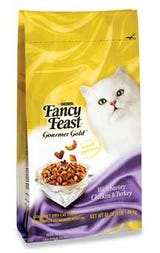 The PET/PE laminated bagstock also keeps grease and moisture inside and guards against punctures and damage from handling. The bag maintains Purina's brand identity with high-impact graphics and additional billboard space that allows for improved visual communication with the consumer.
The PET/PE laminated bagstock also keeps grease and moisture inside and guards against punctures and damage from handling. The bag maintains Purina's brand identity with high-impact graphics and additional billboard space that allows for improved visual communication with the consumer.
Nestle uses the premade film bag in 3- and 7-lb sizes. The resealable tape also helps to keep the package fresh after opening and it prevents infestation. In fact, the film bag maintains freshness so well that consumers no longer need to transfer the food to a secondary container.
Nordenia produces the high-performance, multilayer barrier bag structure at its plant in Jackson, MO, using film printed on a Windmoeller & Hoelscher (www.whcorp.com) press. Designed by the Thompson Design Group (www.ttdg.com), the value-added package is reverse-gravure-printed in six colors using MX inks furnished by Germany's Siegwerk Farbenfabrik (www.siegwerk-group.com).
Thanks to a single web design, the sides and bottom of the bag are covered in wraparound graphics for optimal presentation at point-of-sale, which improves brand identity and adds billboard space for more visual communication to consumers. The luxurious white cat pictured in the main photo vignette appears lifelike against a draping background while the food itself is illustrated in a crystal bowl, conveying sophistication and a quality image that differentiate the product from competitors.
The bag is made on a side-gusset machine from B&B-MAF (www.bub-maf.com). Nordenia indicates that the bag is so durable and moisture-resistant that it may actually be stored outside without fear of damage, and thus helps minimize reclaim costs and bad product. Pet owners are able to scoop or pour the dry food right from the bag and reseal it using the reclosure tape on the back.
Nestle modified existing filling equipment to accommodate the FlexBox style of packaging. With minimal downtime and training of operators, the company was able to meet targeted efficiencies and speeds on its filling lines, PD is told.
The consistent size and shape of the package make it highly cube-efficient, neat and attractive on store shelves. The seal seams along the sides make the FlexBox stable and help it to retain its shape. The Purina Fancy Feast Gourmet Gold FlexBox is made of a laminated PET/PE structure with reverse-printed graphics that protects the printed surface. The glossy PET adds shine that gains shelf impact and brand distinction while the gravure printing is in tight registration. Nordenia developed the new PET/PE bagstock specfically for pet foods like Fancy Feast, to improve grease and moisture barriers.
Artfully printed chicken pouch flies high
A stand-up film pouch perks up Perdue's Bourbon Chicken with its large billboard that readily displays the 26-oz cooked chicken contents. A gold winner in Printing Achievement for Alcan Packaging, the pouch represents a unique use of a 10-color ink press sequence (process and PMS colors) to reproduce photography and a vignette that achieves amazingly realistic graphic imagery and captivates consumers by focusing on the 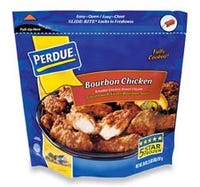 compelling product visual of glazed chicken pieces. A deep blue background reinforces the luxurious presentation while the bright blue and yellow Perdue brand logo supports the generous dose of brand recognition communicated through the graphics.
compelling product visual of glazed chicken pieces. A deep blue background reinforces the luxurious presentation while the bright blue and yellow Perdue brand logo supports the generous dose of brand recognition communicated through the graphics.
The quality flexo-printed imagery was a difficult vignette to produce, according to Joyce Musgrave, market manager at Alcan, who describes the pouchstock as an adhesive lamination of 48-ga polyester and a proprietary sealant film.
“The proprietary LaserTear technology adds value to the Perdue package with consistent separation of materials and a clean, easy-open package with no 'renegade' tears or a compromise of resealable zippers [closures]. In the last decade, consumers have become familiar with it through shredded cheese packaging. Laser technology yields a very precise score to a controlled depth and is capable of extremely tight tolerances. As the film is converted to the final package, this virtually undetectable score becomes a precise tear path.”
The premade gusseted pouches, available in various sizes, are 3.5-mils thick and consist of a reverse-printed PET outer web and a proprietary, “self-manufactured,” or white sealant that Alcan coextrudes. The complete lamination from outside layer to sealant is: PET/reverse printing/adhesive/white sealant film.
Musgrave says, “The improved structure reduced waste, and consequently costs, throughout the system.” Although she says Alcan declines to reveal specific equipment being used to produce and convert the bag, she does say it utilizes 10-color digital flexographic printing technology in its Boscobel, WI, facility to achieve fine, uniform printing featuring outstanding dot shapes. “The quality of the digital printing was particularly evident in the consistency of the Perdue farm vignette, which helps to uniformly reinforce Perdue's brand image. The high-contrast benefits of digital also increases shelf appeal and showcases the product's serving suggestion,” she tells PD.
Additional graphic elements communicate the pouch's functionality, and on the header state the use of Alcan's LaserTear™ technology teamed with a patented Slide-Rite® slider zipper closure from Pactiv Corp. (www.pactiv.com). The Slide-Rite closure is applied in-line during pouchmaking. While zippered packages have become the norm on many consumer packaged-goods since their development in the early 80s, the slider zipper opening/reclosing feature is a welcome device for such a chicken package, which is often used on several occasions; not just once, when the chicken is removed and the package is replaced back in the freezer.
Microwavable veggie bag steams and vents
SteamQuick™ Packaging won a gold award in Technical Innovation for Pliant Corp. (www.pliantcorp.com). The freezable/microwaveable SteamQuick package technology allows frozen foods to steam-cook in a microwave oven right in the bag. As the 12-oz pillow-style bag builds steam when heated in the microwave, it helps cook the food and vents near the end of the cooking cycle. The technology gives consumers both a quick and easy way to have tasty, uniformly heated foods that are ready for mealtime in an easy-to-handle package.
Says Mark Dawson, vp of marketing at Pliant, “The streamers package requires no piercing or removal of the 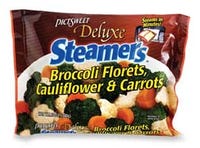 vegetables from the package to complete the cook cycle.” Launched in June 2007, the pouch took 14 months to develop and is currently used by private-label marketers, Dawson says. To meet the requirements of freezable microwavable food packs, the packaging materials must withstand subzero temperatures and high microwave temperatures.
vegetables from the package to complete the cook cycle.” Launched in June 2007, the pouch took 14 months to develop and is currently used by private-label marketers, Dawson says. To meet the requirements of freezable microwavable food packs, the packaging materials must withstand subzero temperatures and high microwave temperatures.
Dawson says the three-layer coex film sealant has excellent seal strength in both high and low temperatures. The sealant's core layer concentrates on the high temperature-resistance while the outer layer utilizes polymers with good cold-temperature durability, he explains. The 2.5- to 3.5-mil rollstock lamination with the proprietary coex sealant is laminated to biaxially oriented PET. Flexo printing is in up to 10 colors. Frozen vegetables typically are microwaved to 212 deg F. The self-venting package features a registered series of vent holes on the back panel that are applied by Pliant. The proprietary technology allows the pouch to self-vent in minutes without the need for a pre-inserted valve. The results afford even cooking throughout the pouch, Dawson notes.
More information is available: |
Flexible Packaging Assn., 410/694-0800. www.flexpack.org. |
Alcan Packaging, 773/399-3538. www.alcanpackaging.com. |
CLP Packaging Solutions, Inc., 978/808-4441. www.clppackagingsolutions.com. |
Nordenia USA, 573/335 4900. www.nordeniausa.com. |
North State Flexibles, LLC, 800/688-7391. www.nsflexibles.com. |
Pliant Corp., 847/969-3323. www.pliantcorp.com. |
Printpack, Inc., 404/691-5830. www.,printpack.com. |
Robbie Mfg., Inc., 800/255-6328. www.robbiemfg.com. |
Watson Standard Adhesives, 401/225-5260. |
About the Author(s)
You May Also Like


